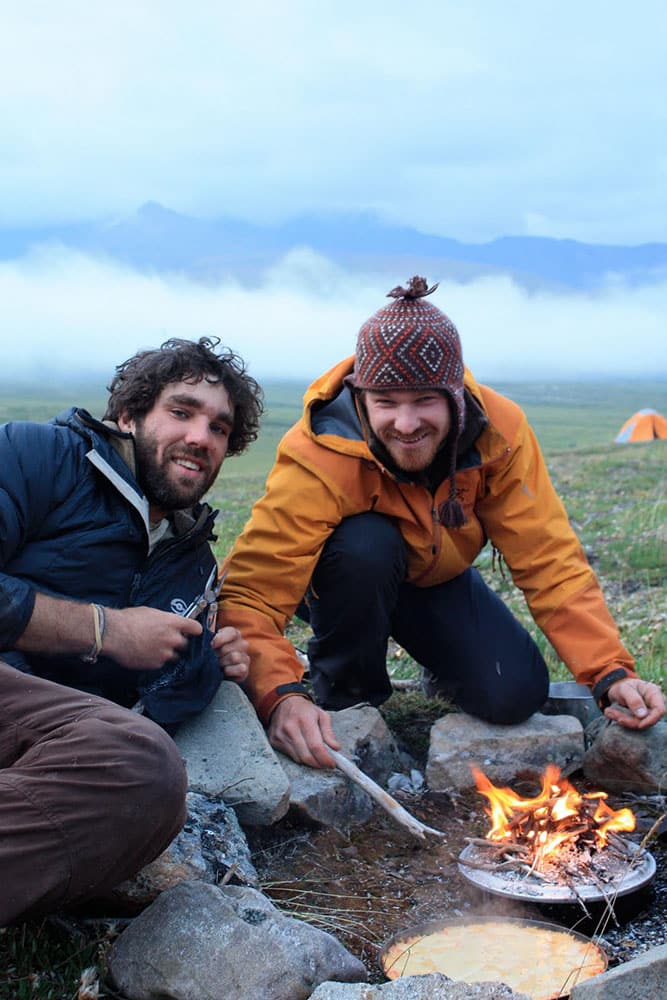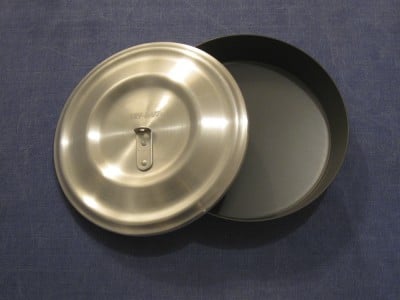They say man only needs two tools in life: WD-40 to make things go, and duct tape to make things stop. To that short list, we’d like to add the Banks Fry-Bake Pan — a truly lightweight frying pan that’s perfect for cooking — and baking — in the backcounry. Fact is we take at least one of these backcountry gastronomic gadgets along on every single one of our courses here at The National Center for Outdoor & Adventure Education. Next to a map and maybe a compass, it’s the most important tool we carry with us.

(Photo courtesy of Banks Fry-Bake Co. Used with permission.)
Keep in mind that we aren’t getting paid a cent for praising this product. Why then are we choosing to devote an entire blog post to it? First off, we’re doing it because we can. You know — freedom of speech and all that. But the real reason is to let our outdoor wilderness course participants — as well as outdoor and wilderness educators across the globe — know that backpacking and outdoor exploration is often a game of weights and convenience. And we can’t think of many things that are as light or as easy to use than Banks’ durable cooking pans.
But here’s what really sold us at NCOAE on the concept of carrying these pans everywhere we trek, hike, raft, climb and camp: Along with our friends over at the National Outdoor Leadership School and Outward Bound, our founders and staff have been using Banks Fry-Bake pans for decades, never once disappointed by their durability and function.
There’s just something about eating in the outdoors that makes the experience almost surreal to the palate. Think about it. Where else but in the wilderness does a big can of stew taste like something from a five-star restaurant? Nowhere else, that’s where!
And with Banks Fry-Bake pans, outdoor enthusiasts and cooks alike can fry freshly caught fish, steam up a pot of veggies, stir-fry chicken, and sauté nearly anything else. You can even bake a cake, should you have a birthday boy or girl on your excursion. Talk about versatile; see the recipe for carrot cake at the end of today’s post!
What these lightweight pans do is take the place of those heavy cast-iron Dutch ovens that used to take up half the room in your backpack. Fry-Bake pans are four to seven pounds lighter, yet they’re so durable, about the only thing that can destroy them are a drop from a commercial airliner.

Expedition Fry-Bake Set (10 ½ inches)
They’re constructed of aluminum, but with an added ingredient: an anodized hardcoat that would make Superman’s abs jealous.
What about cleanup? Easy. Just take the pan to the riverbank and scrub some sand in it. Or use a scouring pad if you want. Because nothing’s going to scratch up that hard surface unless you tie a rope to it and drag the pan behind you on the trail. And why would you want to do that?
These pans are so cleverly constructed, the inventors — a daughter/father team — even made a contoured lid that not only fits tight for baking, but also allows you to strategically place twigs, coals or briquettes on the lid when the pan is sitting on the fire, creating the finest baking appliance outside of a commercial kitchen.
Pam Banks came up with the idea for the Banks Fry-Bake Pan in 1977 while working as a field instructor at NOLS (she was actually backpacking with family and friends in Canyonlands National Park when the idea came to her for the pans). Her father, Pete, an experienced metal manufacturer, helped get the company’s first production run into place and out the door using his Gloucester, Mass.-based business, Bornco, Inc.. Manufacturing moved to Northeast Metal Spinning in Atkinson, N.H., in 1991, where production continues to this day, some 23 years later. Northeast Metal cuts U.S. produced aluminum to the proper sizing for Banks’ Fry-bake pans, and then spins it to the proper shape. The spun pans are then brought to a plating company — Dav-Tech Plating in Marlboro, Mass. — where they are hard anodized and returned to the Banks Fry-Bake Co. in Claverack, NY, for distribution.
But enough about history. No self-respecting write-up about the Fry-Bake Pan would be complete without a recipe. Here, we’re pleased to present ours for carrot cake:
NCOAE Carrot Cake Recipe
Ingredient List
- 1 ½ cups of Duncan Hines Carrot Cake mix
- ¼ tsp. of cinnamon
- ¼ tsp. ground coves
- 1/8 tsp. nutmeg
- 2 tbsp. of nuts
- 2 tsp. wheat germ
- 2 tbsp. dried carrot flakes
- 2 tbsp. powdered egg
- 1 tbsp. powdered milk
- 1 tbsp olive oil
You’ll Also Need
- 1 8 qt. Pot
- 1 12 in. wooden spoon
- 1 Rada Serverspoon
- 1 Expedition Fry-Bake Set (10 ½ inches)
- Materials to build and maintain a medium-heat fire/flame
Directions
- Pour all ingredients — except the one (1) tablespoon of olive — into the eight (8) qt. pot.
- Using a 12-inch wooden spoon, mix the ingredients together for about four (4) minutes, ensuring everything is evenly mixed with the cake mix.
- Next, coat the entire inside of the 10 ½ -inch Expedition Fry-Bake pan and lid using the one (1) tbsp of olive oil.
- Transfer the mixture of ingredients from the eight (8) qt. Pot to the 10 ½ -inch Expedition Fry-Bake pan.
- Place the 10 ½ -inch Expedition Fry-Bake pan over a medium flame, and let cook for eight (8) to 10 minutes.
Important Tip: To ensure proper cooking, add a ‘twiggy fire’ to the top of the Fry-Bake lid. One way to build a twiggy fire is to pre-pack twigs/small sticks in a small Nalgene® bottle containing white gas. When you’re ready to bake, pull them out and build a teepee on the fry bake lid in a four to six-inch diameter and ignite. Another option is to use hot coals from a campfire… place them on the lid of the Fry-Bake lid in a four to six-inch diameter. As most outdoor educators and wilderness guides know, the concept here is to create a true baking environment. We need heat coming from the bottom and top.
- After eight (8) to10 minutes of baking, carefully remove and extinguish the twiggy fire.
- Next, remove the Fry-Bake pan from the medium heat source and allow to stand for around three (3) minutes before serving.
Approximate nutritional information for this recipe, which serves four (4) people, is:
- 703 calories
- 23 grams of fat
- 12 grams carbohydrates
- 10 gram of protein
TALK TO US
Have any further questions about our courses, what you’ll learn, or what else to expect? Contact us, we’re here to help!
Leave a comment